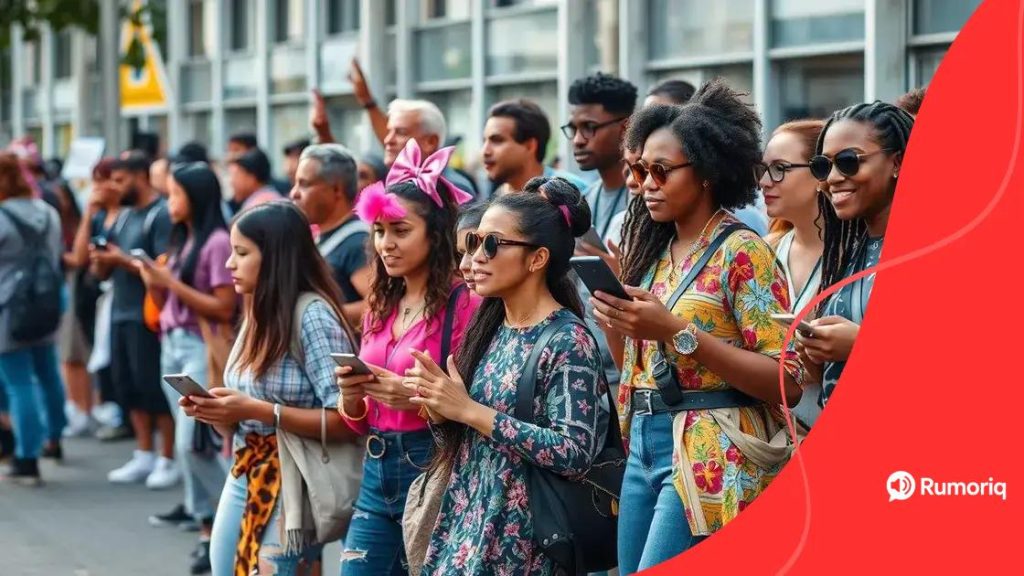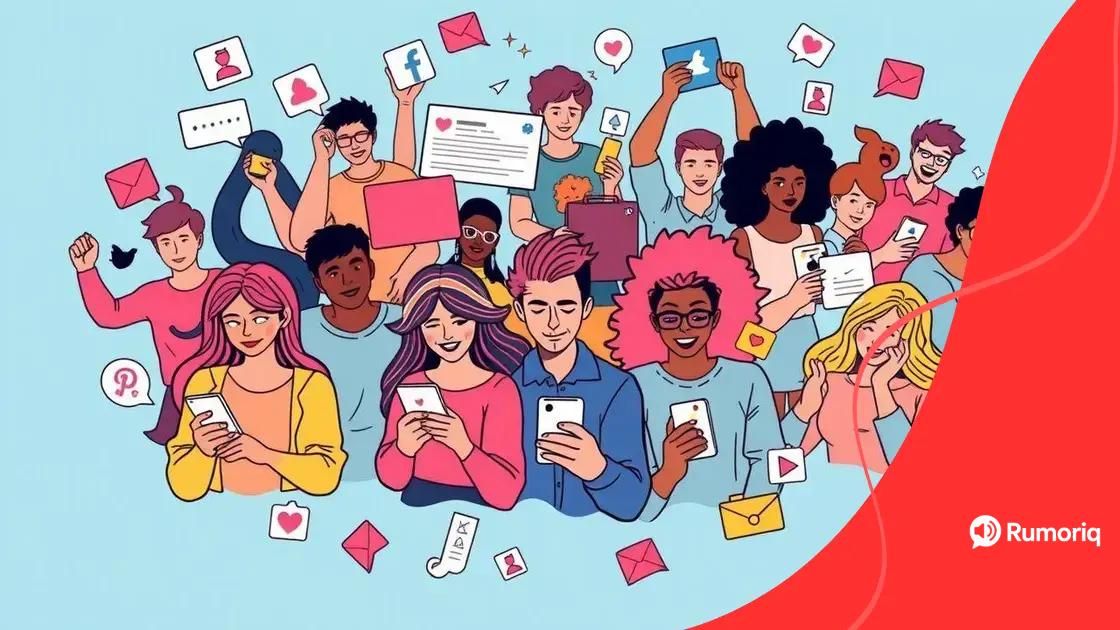US cultural trends 2025: what to expect and embrace

Anúncios
Music and entertainment preferences are rapidly shifting due to the rise of new genres, streaming platforms, and social media influence, while sustainable fashion gains prominence in reflecting cultural values.
US cultural trends 2025 are set to redefine how we live, connect, and express ourselves. Have you ever wondered how these shifts will affect your daily life? Let’s dive into the exciting changes on the horizon.
Anúncios
Exploring the rise of communal living
The rise of communal living is reshaping how we think about home and community. More people are seeking connection, support, and shared resources. This trend reflects a desire for deeper relationships and sustainability.
What is communal living?
Communal living involves people sharing a space, resources, and responsibilities. It’s not just about sharing a house; it’s about creating a community. Residents may share meals, chores, and even finances.
Benefits of communal living
- Cost savings: Sharing rent and utilities can significantly reduce living expenses.
- Stronger connections: Living with others fosters friendships and a sense of belonging.
- Shared responsibilities: Community members can distribute tasks like cooking and cleaning, making life easier for everyone.
As more people seek alternatives to traditional living arrangements, communal spaces are popping up across cities. These places often offer vibrant environments where residents can engage in hobbies together, hold events, or simply support one another.
Anúncios
Moreover, communal living encourages a lifestyle that is often more environmentally friendly. By sharing resources, individuals can reduce their carbon footprint while building a sustainable community.
This growing trend reflects shifting values among younger generations who prioritize experiences and connections over material possessions. In a world where loneliness is increasingly common, communal living offers a comforting solution amidst the chaos of modern life.
The impact of technology on cultural practices
The impact of technology on cultural practices is profound, changing how we communicate, create, and celebrate. With each advancement, we see shifts in our daily lives and traditions.
Changing Communication
Technology has revolutionized how we connect with one another. Social media platforms allow us to share our cultures instantly, helping to bridge gaps between different communities. Virtual gatherings and events have become commonplace, enabling people to celebrate significant cultural events from anywhere.
Influence on Art and Music
Artists and musicians now use digital platforms to share their work with global audiences. This democratization of creativity means emerging talents can discover new styles and collaborate from afar. Technology has also led to new genres of music, driven by innovative tools and software.
- Access to diverse styles: Online platforms provide exposure to global art and music.
- Collaboration opportunities: Artists can work together across continents.
- New art forms: Technology introduces unique ways to create, such as digital art and music production.
Not only does technology influence creative expression, but it also plays a role in preserving cultural heritage. Digital archives and media help document traditions and practices that might otherwise fade. Virtual reality experiences can transport individuals to different cultures, offering immersive learning opportunities.
The interaction between technology and culture continues to evolve, with each development opening new doors for expression and connection. As technology becomes more integrated into our lives, we can expect further innovations that will redefine our understanding of what it means to practice culture today.
How social media is shaping trends

Social media plays a crucial role in shaping trends across various aspects of our lives. Platforms like Instagram, Twitter, and TikTok not only connect us but also influence our purchasing decisions, cultural preferences, and more.
Immediate Access to Trends
With just a few taps, we can discover the latest trends. Social media allows users to see what others are interested in, creating a sense of immediacy. This fast-paced environment helps trends spread rapidly, especially among younger audiences.
Influencers and Their Impact
One significant way social media shapes trends is through influencers. These individuals have the power to impact their followers’ choices by sharing products, styles, and ideas. The authenticity that many influencers project often drives consumer behavior.
- Trust and relatability: Followers often view influencers as friends, making recommendations more persuasive.
- Instant feedback: Trends can evolve quickly based on audience reactions, allowing brands to adapt swiftly.
- Diverse representation: Influencers from different backgrounds showcase a variety of trends, making them accessible to diverse audiences.
Furthermore, social media allows brands to engage directly with their customers. Companies monitor trending topics and conversations to tap into what their audience cares about. By analyzing these interactions, brands can create products that resonate more deeply with consumers.
The viral nature of social media also means that anyone can start a trend. For example, a single video can ignite a challenge or inspire millions, demonstrating the power of collective participation. As these trends evolve, they often reflect broader social changes and interests.
The evolution of sustainable fashion
The evolution of sustainable fashion marks a significant shift in the industry, emphasizing the need for environmentally friendly practices. Over recent years, consumers have become more aware of how their clothing choices impact the world.
Understanding Sustainable Fashion
Sustainable fashion focuses on creating clothing, accessories, and footwear in a way that is environmentally friendly and socially responsible. This includes using eco-friendly materials, ethical labor practices, and reducing waste throughout the production process.
Key Trends in Sustainable Fashion
Several trends are shaping the future of sustainable fashion. As consumers demand more transparency, brands are responding by adopting practices that promote sustainability. Here are some important trends:
- Recycled materials: Brands are increasingly using recycled fabrics to create new clothing, reducing the need for virgin materials.
- Slow fashion: This movement encourages buying fewer, high-quality pieces rather than cheap, fast-produced items.
- Transparency: Many brands are now sharing their production processes and sourcing information, allowing consumers to make informed choices.
The rise of digital platforms has also enabled the growth of sustainable fashion. Online marketplaces provide innovative new brands the chance to reach broader audiences. Consumers can now easily find brands committed to sustainable practices, making it easier to support eco-friendly choices.
As fashion evolves, so does the emphasis on sustainability in the design phase. Designers are incorporating sustainable principles into their work, focusing on durability and timelessness. This shift helps combat the throwaway culture associated with fast fashion.
Ultimately, the evolution of sustainable fashion is set to continue as more consumers prioritize environmental impact. This movement is reshaping an industry that has long prioritized speed and cost over ethical considerations.
Shifts in music and entertainment preferences
Shifts in music and entertainment preferences have been shaped by cultural changes and technological advancements. As new genres and platforms emerge, our consumption habits are evolving rapidly.
New Genres and Styles
Musical tastes have diversified significantly in recent years. Genres like hip-hop, electronic, and indie pop are now more popular than ever, reflecting a blend of cultural influences. With global artists collaborating, listeners enjoy a mix of sounds from different parts of the world.
Streaming Services Revolution
The rise of streaming services has transformed how we access music and entertainment. Unlike traditional media, streaming allows users to explore vast libraries of content. Popular platforms allow listeners to create personalized playlists and discover new artists easily.
- Accessibility: Streaming makes it possible for anyone to listen to any genre, anytime, anywhere.
- Curated experiences: Algorithms recommend music based on individual preferences, creating a more personal experience.
- Global reach: Artists can reach international audiences without the need for major label support.
In addition, social media platforms play a crucial role in shaping trends in music. Viral challenges and dance trends on platforms like TikTok have propelled songs to the top of the charts, demonstrating how digital culture influences music success.
Moreover, live-streaming concerts have become popular, allowing fans to engage with artists from the comfort of their homes. This change has made live music more accessible while also engendering a sense of community among viewers.
As music and entertainment continue to evolve, one thing is clear: our preferences are becoming increasingly influenced by technology and global culture, paving the way for innovative expressions of creativity.
In conclusion, the world of music and entertainment is constantly changing. With the rise of new genres, streaming services, and social media, our preferences are evolving. The embrace of sustainable fashion shows a commitment to the environment. As we navigate these shifts, it’s clear that technology and culture are intertwined, leading to innovative expressions of creativity that resonate with audiences everywhere.
\n\n
\n
FAQ – Frequently Asked Questions about Music and Entertainment Trends
What are the latest trends in music today?
Today, genres like hip-hop, electronic, and indie pop are gaining popularity, reflecting a blend of cultural influences.
How have streaming services changed the way we consume music?
Streaming services provide instant access to a vast library of music, allowing users to discover new artists and create personalized playlists.
What role does social media play in shaping entertainment preferences?
Social media influences music trends through viral challenges and promotions, helping artists reach larger audiences quickly.
How is sustainable fashion connected to music and entertainment trends?
Sustainable fashion is increasingly featured in music and entertainment, with artists promoting eco-friendly clothing as part of their brand image.